Seepage Mechanism of Tight Sandstone Reservoir Based on Digital Core Simulation Method
Abstract
1. Introduction
2. Modeling of the Digital Core
3. Difference Equations for Digital Cores
4. Stability Analysis of Difference Equations
4.1. Parameter Selection
4.2. D Matrix Block Modeling
4.3. Orthogonal Test Analysis
4.4. Results and Discussion
5. Conclusions
Author Contributions
Funding
Institutional Review Board Statement
Informed Consent Statement
Data Availability Statement
Conflicts of Interest
References
- Du, S.; Pang, S.; Shi, Y. Quantitative characterization on the microscopic pore heterogeneity of tight oil sandstone reservoir by considering both the resolution and representativeness. J. Pet. Sci. Eng. 2018, 169, 388–392. [Google Scholar] [CrossRef]
- Zhang, Y.; Zeng, J.; Dai, Z.; Viswanathan, H.; Xiao, T.; Ma, Y.; Feng, X. Experimental investigation on oil migration and accumulation in tight sandstones. J. Pet. Sci. Eng. 2018, 160, 267–275. [Google Scholar] [CrossRef]
- Hu, S.; Zhou, C.; Li, X.; Li, C.; Zhang, S. A tight sandstone trapezoidal pore oil saturation model. Pet. Explor. Dev. 2017, 44, 876–886. [Google Scholar] [CrossRef]
- Li, J.; Li, X.R.; Song, M.S.; Liu, H.M.; Feng, Y.C.; Liu, C. Investigating microscopic seepage characteristics and fracture effectiveness of tight sandstones: A digital core approach. Pet. Sci. Vol. 2021, 18, 173–182. [Google Scholar] [CrossRef]
- Lai, J.; Wang, G.; Chen, J.; Wang, S.; Zhou, Z.; Fan, X. Origin and Distribution of Carbonate Cement in Tight Sandstones: The Upper Triassic Yanchang Formation Chang 8 Oil Layer in West Ordos Basin, China. Geofluids 2017, 2017, 8681753. [Google Scholar] [CrossRef]
- Liu, B.; Yao, S.; Hu, W.; Cao, J. Applying octamethylcyclotetrasiloxane as a probe liquid for characterizing the pore size distribution of oil-bearing tight sandstones by nuclear magnetic resonance cryoporometry. Mar. Pet. Geol. 2017, 88, 814–825. [Google Scholar] [CrossRef]
- Xi, K.; Cao, Y.; Liu, K.; Zhu, R. Factors influencing oil saturation and exploration fairways in the lower cretaceous Quantou Formation tight sandstones, Southern Songliao Basin, China. Energy Explor. Exploit. 2018, 36, 1061–1085. [Google Scholar] [CrossRef]
- Yilmaz, M.; Tugrul, A. The effects of different sandstone aggregates on concrete strength. Constr. Build. Mater. 2012, 35, 294–303. [Google Scholar] [CrossRef]
- Petrounias, P.; Giannakopoulou, P.P.; Rogkala, A.; Kalpogiannaki, M.; Koutsovitis, P.; Damoulianou, M.E.; Koukouzas, N. Petrographic Characteristics of Sandstones as a Basis to Evaluate Their Suitability in Construction and Energy Storage Applications. A Case Study from Klepa Nafpaktias (Central Western Greece). Energies 2020, 13, 119. [Google Scholar] [CrossRef]
- Bessa, M.A.; Bostanabad, R.; Liu, Z.; Hu, A.; Apley, D.W.; Brinson, C.; Chen, W.; Liu, W.K. A framework for data-driven analysis of materials under uncertainty: Countering the curse of dimensionality. Comput. Methods Appl. Mech. Eng. 2017, 320, 633–667. [Google Scholar] [CrossRef]
- Bodla, K.K.; Garimella, S.V.; Murthy, J.Y. 3D reconstruction and design of porous media from thin sections. Int. J. Heat Mass Transf. 2014, 73, 250–264. [Google Scholar] [CrossRef]
- Ferreira, K.M.; de Queiroz, T.A. Two effective simulated annealing algorithms for the Location-Routing Problem. Appl. Soft Comput. 2018, 70, 389–422. [Google Scholar] [CrossRef]
- Bostanabad, R.; Bui, A.T.; Xie, W.; Apley, D.W.; Chen, W. Stochastic microstructure characterization and reconstruction via supervised learning. Acta Mater. 2016, 103, 89–102. [Google Scholar] [CrossRef]
- Feng, J.; Teng, Q.; He, X.; Qing, L.; Li, Y. Reconstruction of three-dimensional heterogeneous media from a single two-dimensional section via co-occurrence correlation function. Comput. Mater. Sci. 2018, 144, 181–192. [Google Scholar] [CrossRef]
- Izadi, H.; Baniassadi, M.; Hasanabadi, A.; Mehrgini, B.; Memarian, H.; Soltanian-Zadeh, H.; Abriniac, K. Application of full set of two point correlation functions from a pair of 2D cut sections for 3D porous media reconstruction. J. Pet. Sci. Eng. 2017, 149, 789–800. [Google Scholar] [CrossRef]
- Xu, H.; Dikin, D.A.; Burkhart, C.; Chen, W. Descriptor-based methodology for statistical characterization and 3D reconstruction of microstructural materials. Comput. Mater. Sci. 2014, 85, 206–216. [Google Scholar] [CrossRef]
- Hajizadeh, A.; Safekordi, A.; Farhadpour, F.A. A multiple-point statistics algorithm for 3D pore space reconstruction from 2D images. Adv. Water Resour. 2011, 34, 1256–1267. [Google Scholar] [CrossRef]
- Hasanabadi, A.; Baniassadi, M.; Abrinia, K.; Safdari, M.; Garmestani, H. 3D microstructural reconstruction of heterogeneous materials from 2D cross sections: A modified phase-recovery algorithm. Comput. Mater. Sci. 2016, 111, 107–115. [Google Scholar] [CrossRef]
- Mekki, A.; Ali, M.M. Numerical simulation of Kadomtsev–Petviashvili–Benjamin–Bona–Mahony equations using finite difference method. Appl. Math. Comput. 2013, 219, 11214–11222. [Google Scholar] [CrossRef]
- Song, G.; Li, Y.; Wang, W.; Jiang, K.; Shi, Z.; Yao, S. Investigation on the mechanical properties and mechanical stabilities of pipewall hydrate deposition by modelling and numerical simulation. Chem. Eng. Sci. 2018, 192, 477–487. [Google Scholar] [CrossRef]
- Tomé, M.F.; de Araujo, M.S.B.; Alves, M.A.; Pinho, F.T. Numerical simulation of viscoelastic flows using integral constitutive equations: A finite difference approach. J. Comput. Phys. 2008, 227, 4207–4243. [Google Scholar] [CrossRef]
- Okabe, H.; Blunt, M.J. Pore space reconstruction using multiple-point statistics. J. Pet. Sci. Eng. 2005, 46, 121–137. [Google Scholar] [CrossRef]
- Zhou, X.P.; Xiao, N. 3D Numerical Reconstruction of Porous Sandstone Using Improved Simulated Annealing Algorithms. Rock Mech. Rock Eng. 2018, 51, 2135–2151. [Google Scholar] [CrossRef]
- Saxena, N.; Mavko, G.; Hofmann, R.; Srisutthiyakorn, N. Estimating permeability from thin sections without reconstruction: Digital rock study of 3D properties from 2D images. Comput. Geosci. 2017, 102, 79–99. [Google Scholar] [CrossRef]
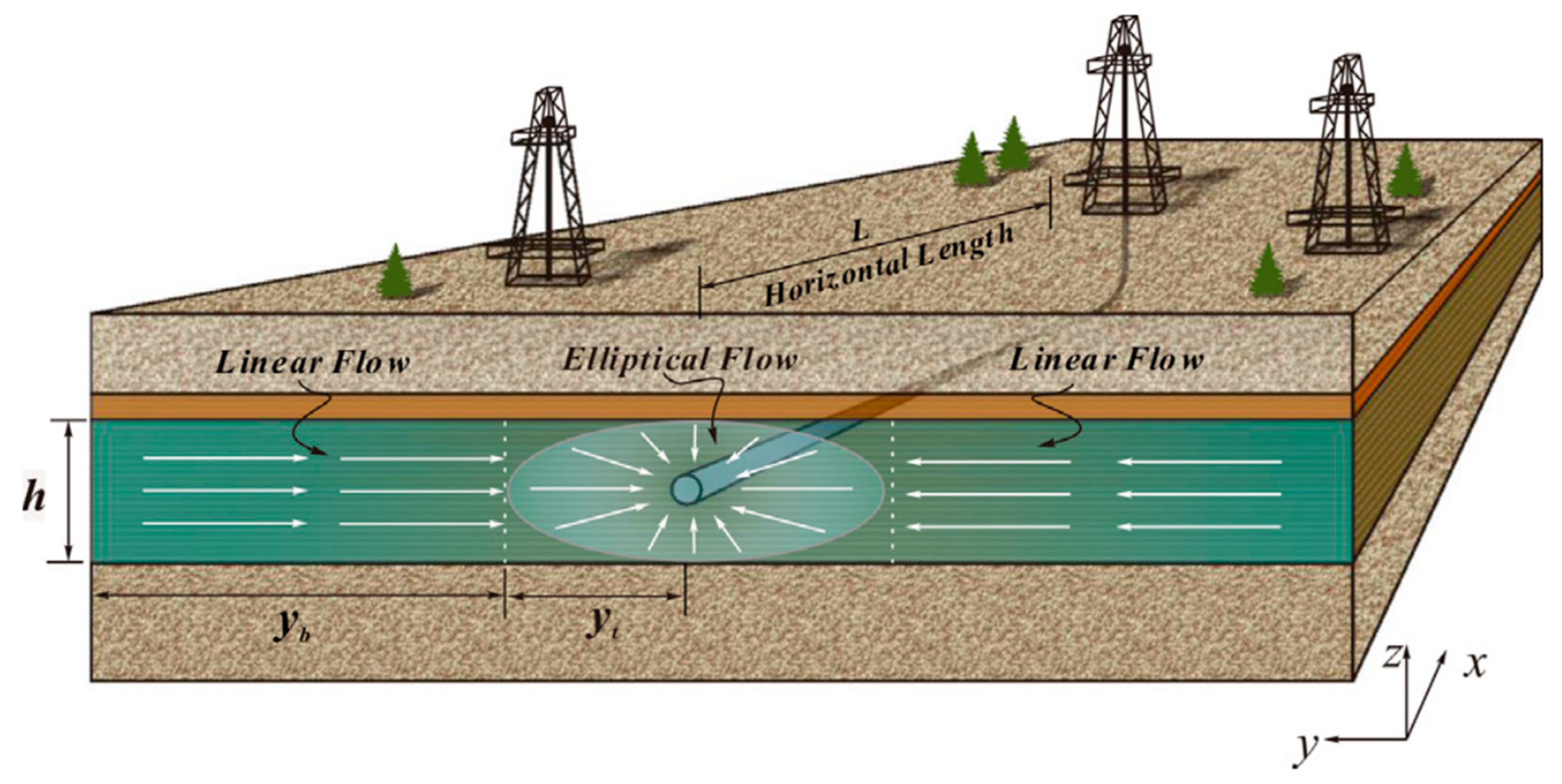
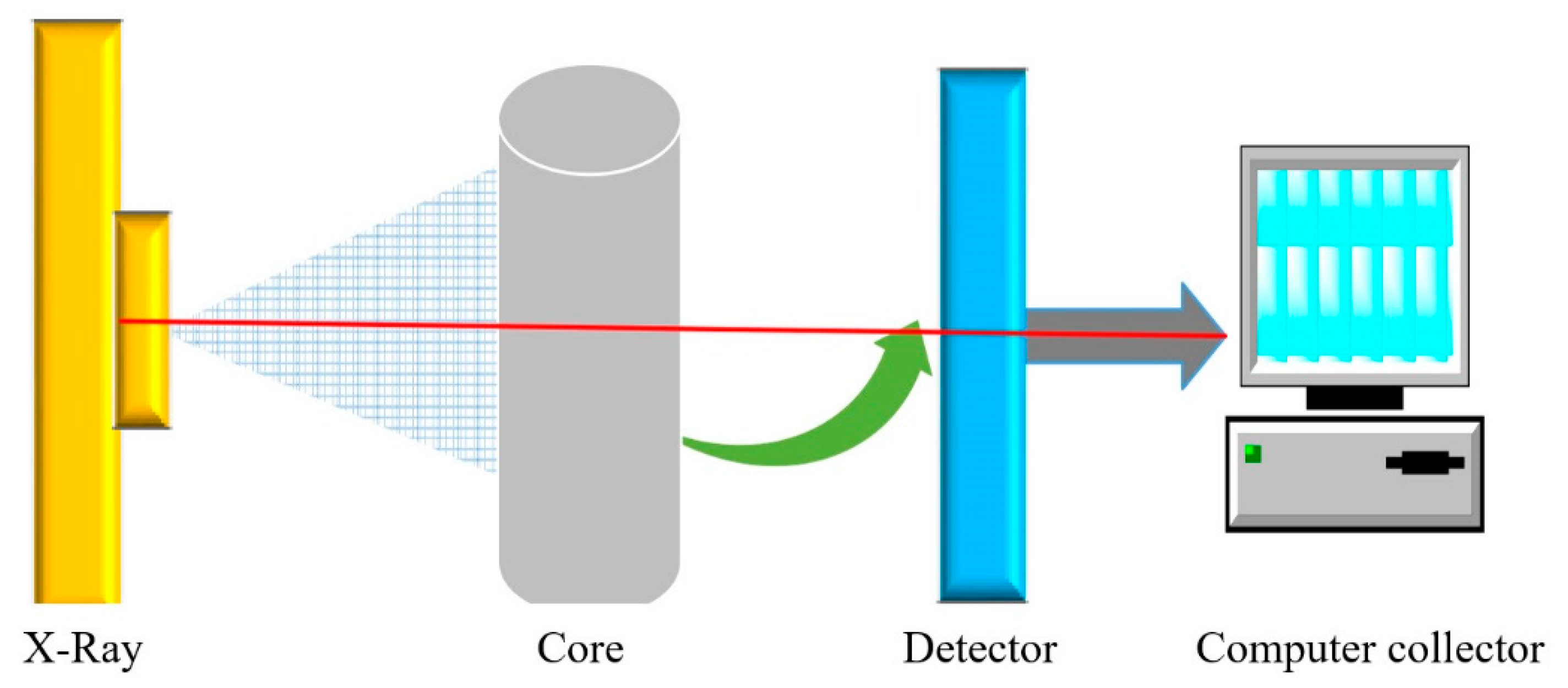
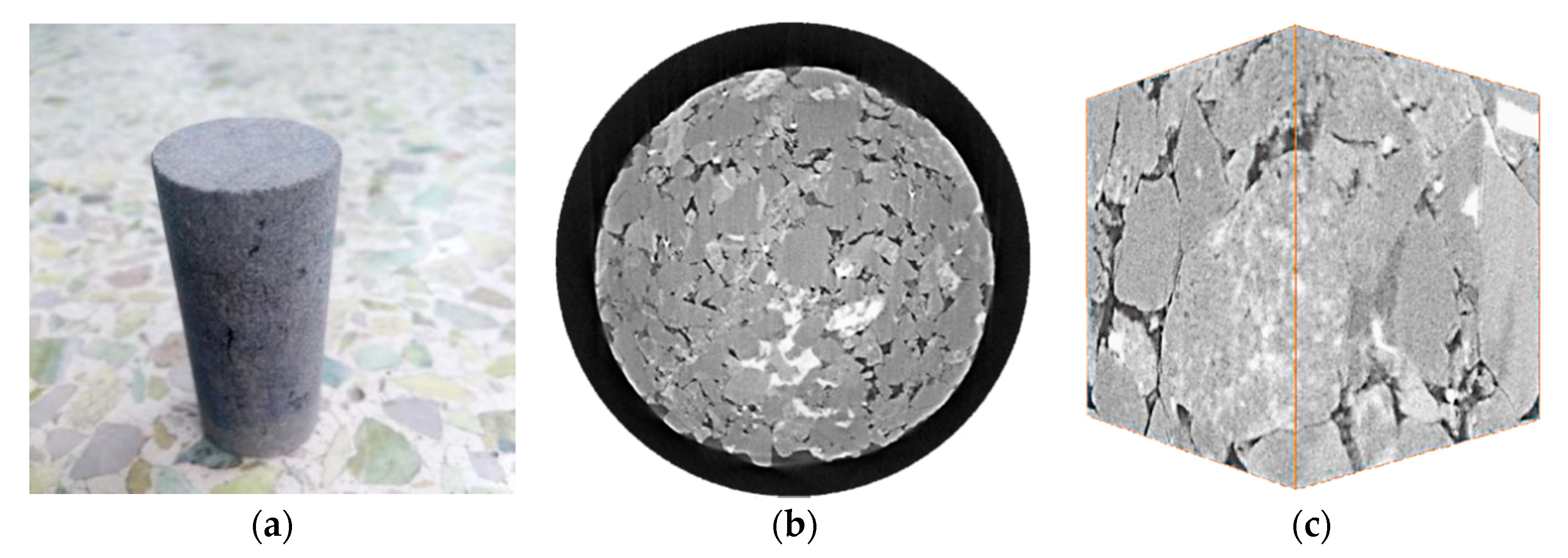

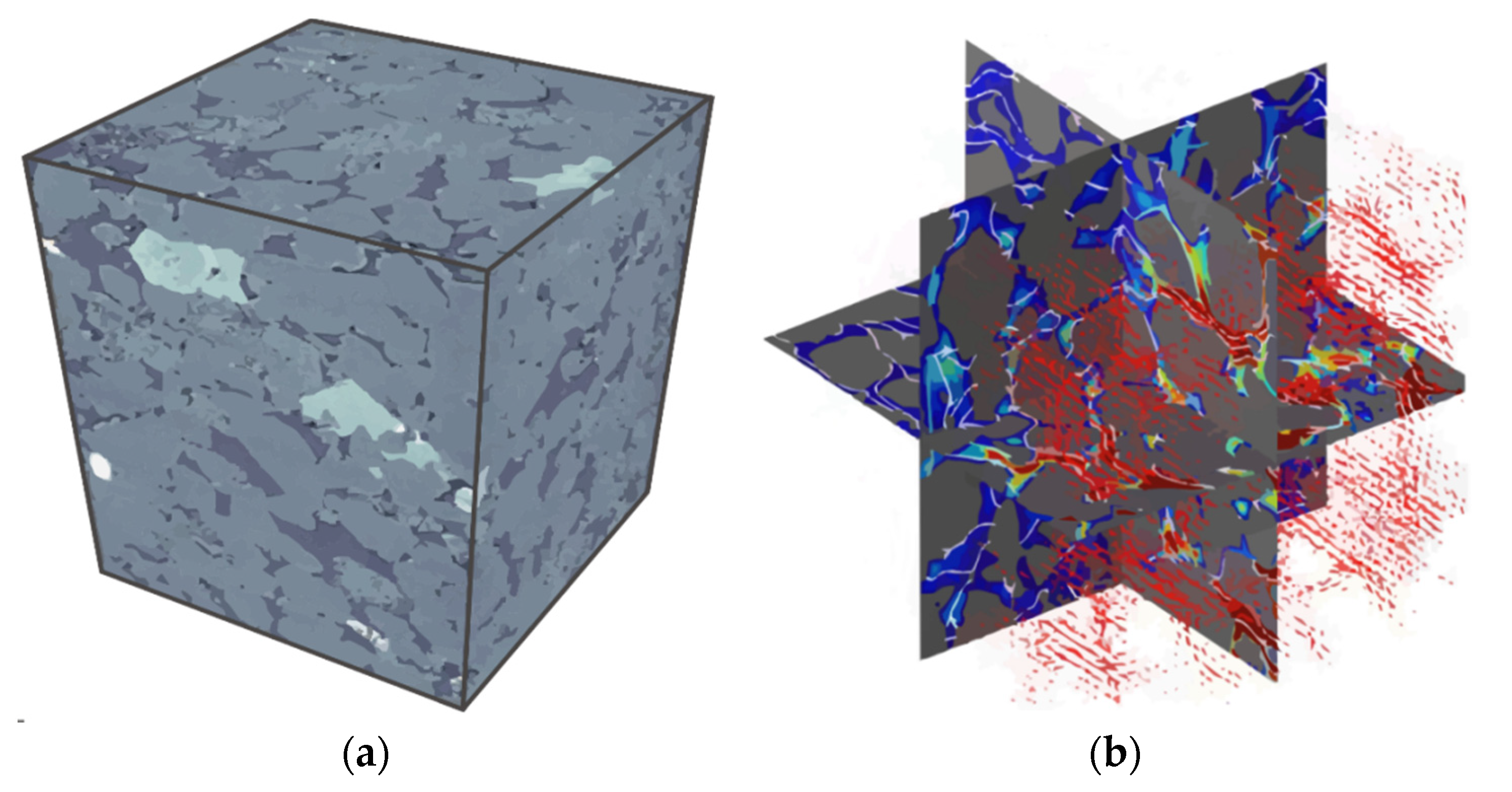

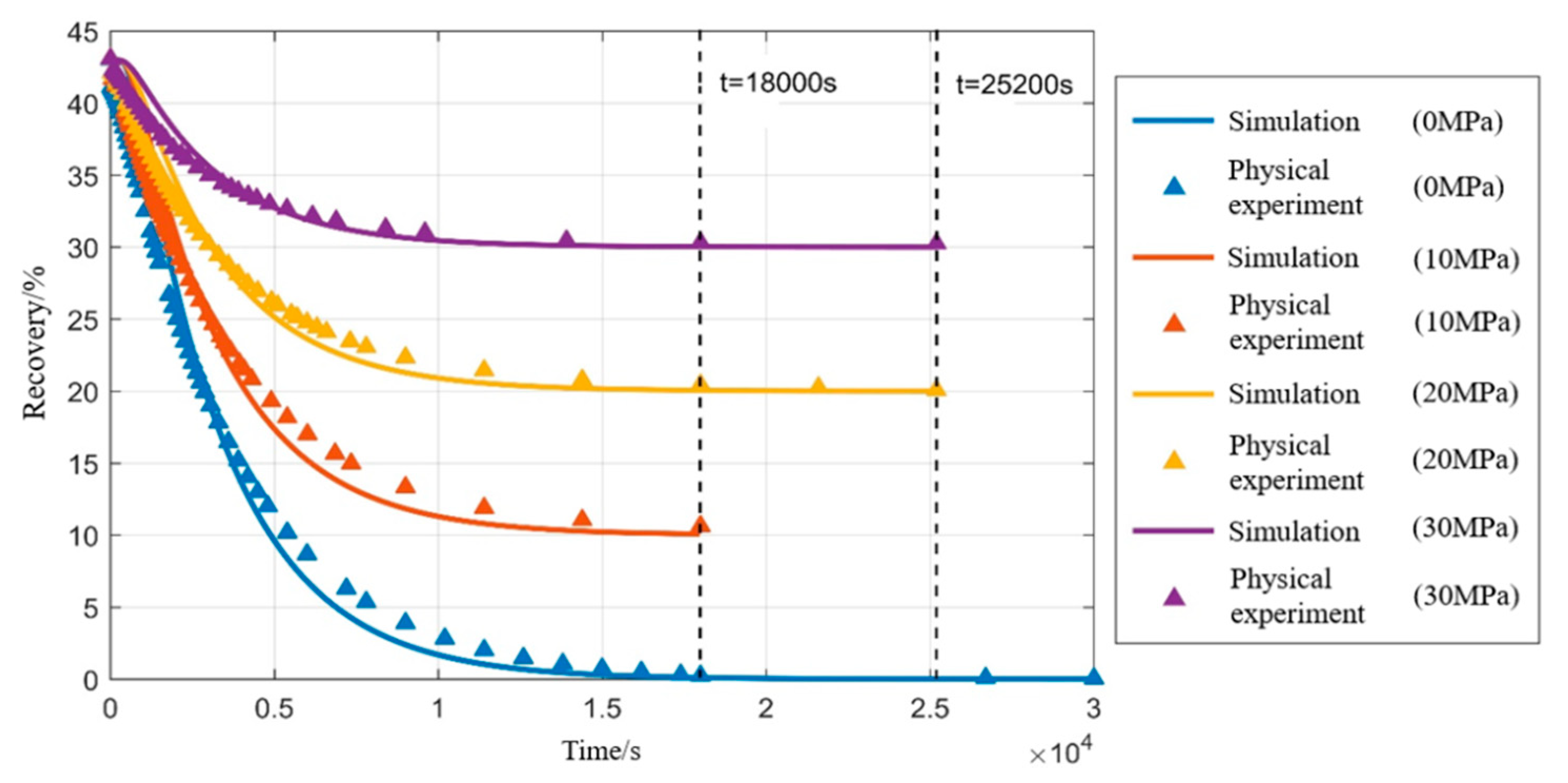
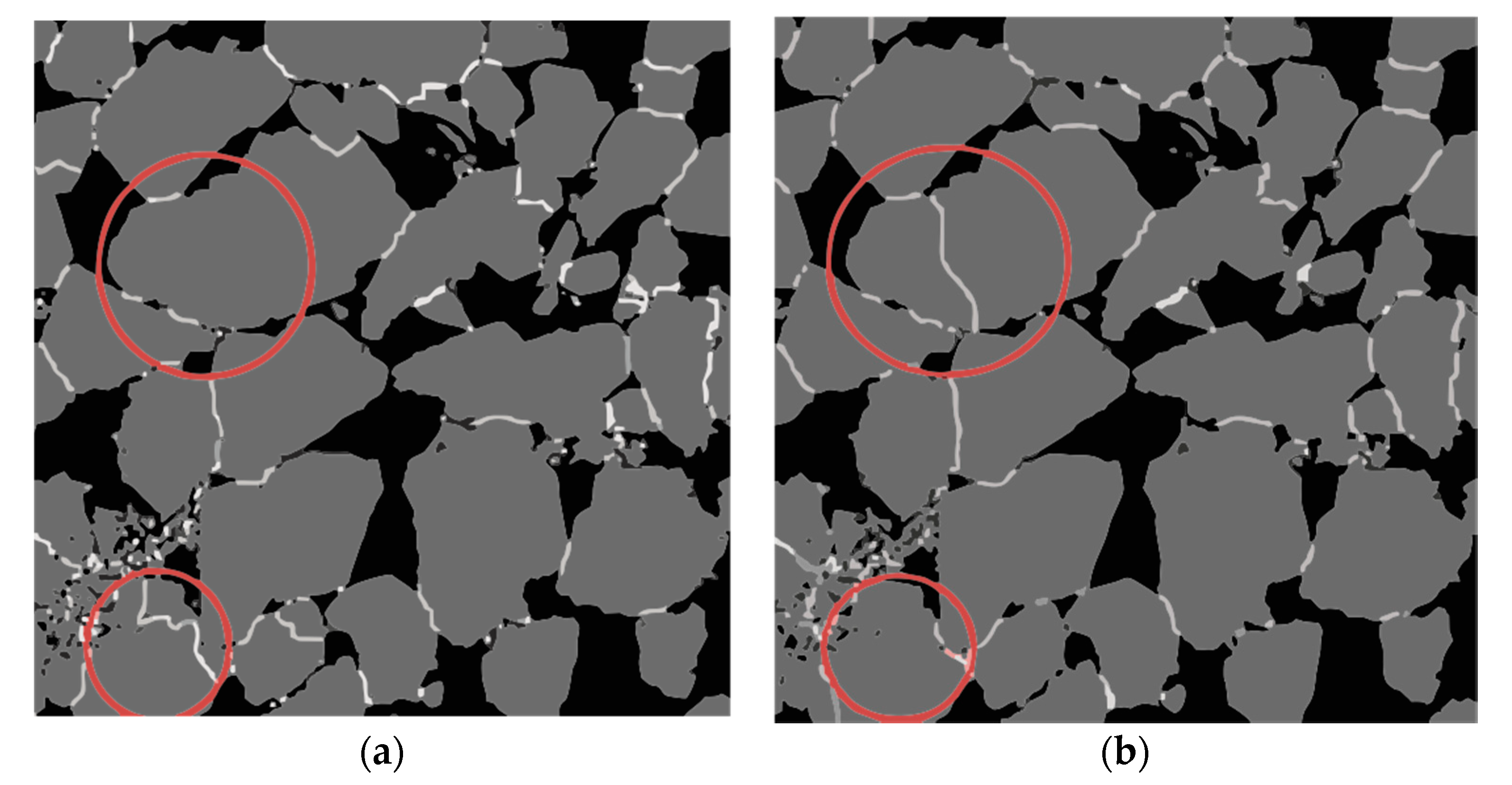
| Symbol | Meaning | Symbol | Meaning |
|---|---|---|---|
| v | Seepage velocity (cm/d) | Cl- | Fluid compression factor (MPa−1) |
| ρ | Density of oil (underground) (g/cm3) | k | Matrix permeability (10−3 μm2) |
| a | Density of oil (g/cm3) | Pw | Downstream crack pressure (MPa) |
| L | Core length (m) | Pi | Original formation pressure (MPa) |
| Ct | Comprehensive compression factor (MPa−1) | Crude oil viscosity (mPas) | |
| Cf- | Rock compression factor (MPa−1) | Pressure coefficient | |
| Formation porosity | G | Starting pressure gradient (MPa/m) |
| Parameter | Value | Parameter | Value |
|---|---|---|---|
| Core length (cm) | 6.77 | Matrix pressure (Mpa) | 43 |
| Downstream pressure (Mpa) | 0–30 | Matrix permeability (mD) | 0.075 |
| Crude oil viscosity (mPa·s) | 1.8 | Comprehensive compression factor (MPa−1) | 3.6 × 10−4 |
| Liquid compression factor (MPa−1) | 3 × 10−3 | Starting pressure gradient (MPa/cm) | 3.15 × 10−2 |
| Factor | Pressure (MPa) | Viscosity (mPa·s) | Permeability (mD) | Length (m) | Time (h) | |
|---|---|---|---|---|---|---|
| Lwvel | ||||||
| 1 | 10 | 0.6 | 0.075 | 3.25 | 2.5 | |
| 2 | 20 | 1.2 | 0.15 | 6.5 | 5 | |
| 3 | 30 | 1.8 | 0.225 | 9.75 | 7.5 | |
| 4 | 40 | 2.4 | 0.3 | 13 | 10 |
| Factor | Pressure (MPa) | Viscosity (mPa·s) | Permeability (mD) | Length (cm) | Time (h) | Recovery (%) | |
|---|---|---|---|---|---|---|---|
| Order | |||||||
| 1 | 10 | 0.6 | 0.075 | 3.25 | 2.5 | 3.27 | |
| 2 | 10 | 1.2 | 0.15 | 6.5 | 5 | 3.29 | |
| 3 | 10 | 1.8 | 0.225 | 9.75 | 7.5 | 3.13 | |
| 4 | 10 | 2.4 | 0.3 | 13 | 10 | 2.87 | |
| 5 | 20 | 0.6 | 0.15 | 9.75 | 10 | 6.06 | |
| 6 | 20 | 1.2 | 0.075 | 13 | 7.5 | 3.79 | |
| 7 | 20 | 1.8 | 0.3 | 3.25 | 5 | 15.54 | |
| 8 | 20 | 2.4 | 0.225 | 6.5 | 2.5 | 5.39 | |
| 9 | 30 | 0.6 | 0.225 | 13 | 5 | 9.96 | |
| 10 | 30 | 1.2 | 0.3 | 9.75 | 2.5 | 9.96 | |
| 11 | 30 | 1.8 | 0.075 | 6.5 | 10 | 9.03 | |
| 12 | 30 | 2.4 | 0.15 | 3.25 | 7.5 | 15.51 | |
| 13 | 40 | 0.6 | 0.3 | 6.5 | 7.5 | 13.16 | |
| 14 | 40 | 1.2 | 0.225 | 3.25 | 10 | 12.99 | |
| 15 | 40 | 1.8 | 0.15 | 13 | 2.5 | 9.29 | |
| 16 | 40 | 2.4 | 0.075 | 9.75 | 5 | 8.64 |
| Factor | Pressure (MPa) | Viscosity (mPa·s) | Permeability (mD) | Length (cm) | Time (h) | |
|---|---|---|---|---|---|---|
| Level | ||||||
| 1 | 3.14 | 8.1125 | 6.1825 | 11.8275 | 6.9775 | |
| 2 | 7.695 | 7.5075 | 8.5375 | 7.7175 | 9.3575 | |
| 3 | 11.115 | 9.2475 | 7.8675 | 6.9475 | 8.8975 | |
| 4 | 11.02 | 8.1025 | 10.3825 | 6.4775 | 7.7375 | |
| Difference | 7.975 | 1.135 | 4.2 | 5.35 | 2.38 |
Publisher’s Note: MDPI stays neutral with regard to jurisdictional claims in published maps and institutional affiliations. |
© 2021 by the authors. Licensee MDPI, Basel, Switzerland. This article is an open access article distributed under the terms and conditions of the Creative Commons Attribution (CC BY) license (https://creativecommons.org/licenses/by/4.0/).
Share and Cite
Wu, H.; Dong, X.; Xu, Y.; Xiong, G.; Shen, Z.; Wang, Y. Seepage Mechanism of Tight Sandstone Reservoir Based on Digital Core Simulation Method. Appl. Sci. 2021, 11, 3741. https://doi.org/10.3390/app11093741
Wu H, Dong X, Xu Y, Xiong G, Shen Z, Wang Y. Seepage Mechanism of Tight Sandstone Reservoir Based on Digital Core Simulation Method. Applied Sciences. 2021; 11(9):3741. https://doi.org/10.3390/app11093741
Chicago/Turabian StyleWu, Huaiyu, Xisong Dong, Yang Xu, Gang Xiong, Zhen Shen, and Yong Wang. 2021. "Seepage Mechanism of Tight Sandstone Reservoir Based on Digital Core Simulation Method" Applied Sciences 11, no. 9: 3741. https://doi.org/10.3390/app11093741
APA StyleWu, H., Dong, X., Xu, Y., Xiong, G., Shen, Z., & Wang, Y. (2021). Seepage Mechanism of Tight Sandstone Reservoir Based on Digital Core Simulation Method. Applied Sciences, 11(9), 3741. https://doi.org/10.3390/app11093741








